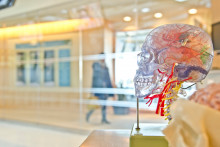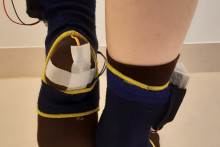The research findings were published in Physical Review Letters in May. They showed that properties of protein alpha-synuclein, which plays a central role in Parkinson’s disease, can be ‘tuned’ – by temperature.
The higher the temperature, the stronger the network
‘The protein alpha-synuclein is naturally present in the brain. It forms specific fibrils and our goal was to investigate how these fibrils interact,’ Professors Claessens explains the objective of the research project. ‘When the protein gets misfolded, it starts assembling these fibrils that accumulate into plaques where many other different proteins accumulate. This is characteristic for Parkinson, yet it is unknown why it happens. Thanks to our findings, we might have a better idea of how the disease works.’
‘While most physical interactions become weaker when exposed to higher temperatures, we have proven that the fibrils of alpha-synuclein react completely differently – the connection between the fibrils becomes stronger when the temperature is increased,’ continues Claessens. ‘This shows that we can tune their interaction using temperature. Even though we are talking of temperatures that would never occur in the brain, understanding this mechanism could help us find ways to intervene with Parkinson’s disease.’
‘What should save us, makes it worse’
Besides the protein’s unusual reaction to ‘heat’, Claessens’ recent research points to another important process related to Parkinson. It appears that the body’s own natural defenses work against us in case of the neurodegenerative disease. ‘The natural process is for enzymes to “cut off” the electrically charged ends of the potentially dangerous protein fibrils. However, this means that the hydrophobic part is even more exposed and the fibrils can interact, form networks and attack cell membranes. So what should save us, actually makes it worse,’ clarifies the professor.
Claessens’ group will now continue with research on alpha-synuclein. ‘It’s a very strange protein,’ says the scientist. ‘Unlike others, it has no structure, it behaves more like random polymers. It may adopt different functions. I want to understand how nature uses this “non-structure”. My entire work is about understanding nature and its mechanisms. That can help us figure out strategies against diseases.’







